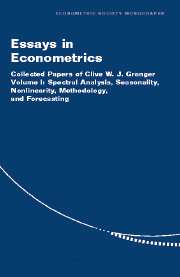Book contents
- Frontmatter
- Contents
- Acknowledgments
- List of Contributors
- Introduction
- 1 The ET Interview: Professor Clive Granger
- PART ONE SPECTRAL ANALYSIS
- PART TWO SEASONALITY
- PART THREE NONLINEARITY
- PART FOUR METHODOLOGY
- 11 Time Series Modeling and Interpretation
- 12 On the Invertibility of Time Series Models
- 13 Near Normality and Some Econometric Models
- 14 The Time Series Approach to Econometric Model Building
- 15 Comments on the Evaluation of Policy Models
- 16 Implications of Aggregation with Common Factors
- PART FIVE FORECASTING
- Index
16 - Implications of Aggregation with Common Factors
Published online by Cambridge University Press: 06 July 2010
- Frontmatter
- Contents
- Acknowledgments
- List of Contributors
- Introduction
- 1 The ET Interview: Professor Clive Granger
- PART ONE SPECTRAL ANALYSIS
- PART TWO SEASONALITY
- PART THREE NONLINEARITY
- PART FOUR METHODOLOGY
- 11 Time Series Modeling and Interpretation
- 12 On the Invertibility of Time Series Models
- 13 Near Normality and Some Econometric Models
- 14 The Time Series Approach to Econometric Model Building
- 15 Comments on the Evaluation of Policy Models
- 16 Implications of Aggregation with Common Factors
- PART FIVE FORECASTING
- Index
Summary
Many observed macrovariables are simple aggregates over a large number of microunits. It is pointed out that the generating process of the macrovariables is largely determined by the common factors in the generating mechanisms of the microvariables, even though these factors may be very unimportant at the microlevel. It follows that macrorelationships are simpler than the complete microrelationships, but that empirical investigations of microrelationships may not catch those components, containing common factors, which will determine the macrorelationship. It is also shown that an aggregate expectation or forecast is simply the common factor component of the individual agents' expectations.
INTRODUCTION
Macroeconometric models have to be constructed from the data that is available rather than from ideal data. In practice, many important macrovariables are measured as unweighted sums of quantities observed for microunits, such as firms or families. Obvious examples include production of agricultural commodities, profits, employment, and consumption. One aspect of this aggregation procedure that has received little attention is the immense size of many actual economies. For example, the current U.S. economy contains over 80 million households and two and a half million corporations. These numbers are so large that various statistical limit theorems will strongly apply, so that if simplistic assumptions about the microunits are correct, there will be clear implications for macromodels relating aggregate series. The degree of explanation of one variable by another could be very high and residuals be perfectly normally distributed.
Information
- Type
- Chapter
- Information
- Essays in EconometricsCollected Papers of Clive W. J. Granger, pp. 336 - 352Publisher: Cambridge University PressPrint publication year: 2001
